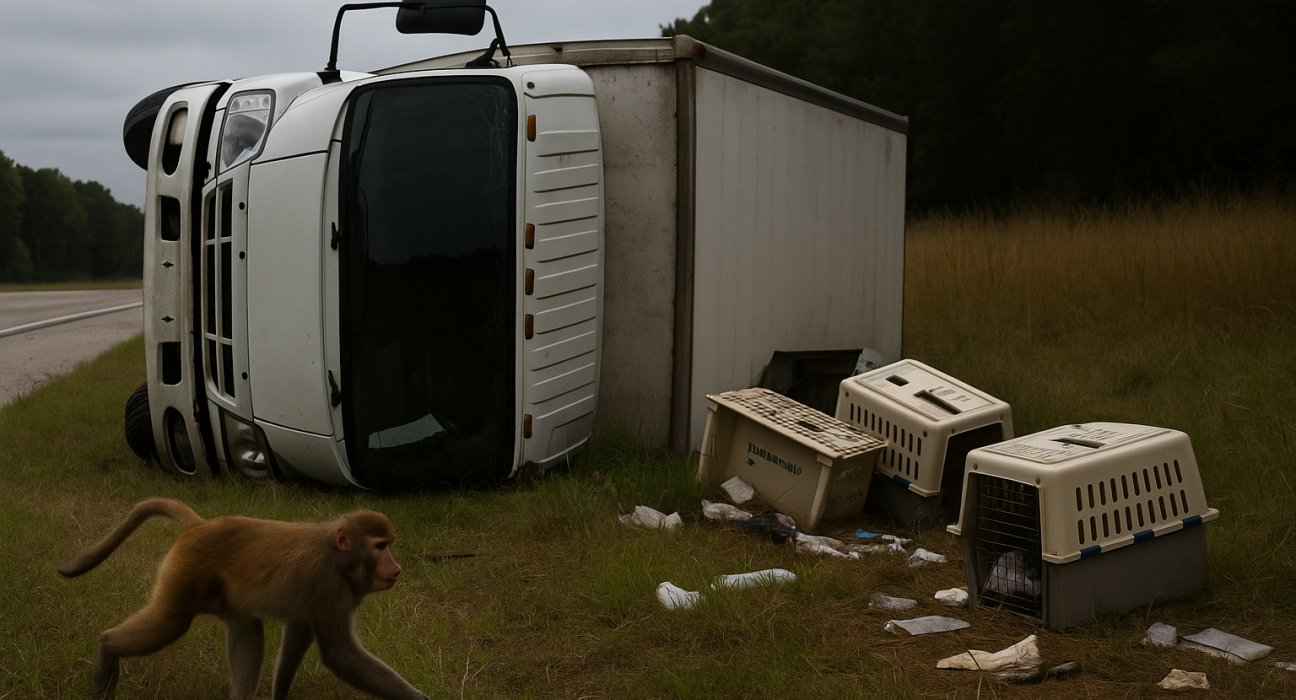On Tuesday, 28 October 2025, a truck transporting rhesus monkeys overturned on Interstate 59 near Heidelberg in Jasper County, Mississippi. The cargo reportedly included rhesus monkeys being moved from a biomedical-research facility toward another location.
In the immediate aftermath, the Jasper County Sheriff’s Department issued public warnings that several “aggressive” monkeys had escaped and may be disease-carrying—citing potential infection with herpes, hepatitis C and COVID-19. Responding crews from Mississippi Wildlife and Fisheries, law enforcement, and animal-care teams were dispatched to recover or contain the animals. Videos showed monkeys crawling through tall grass alongside the interstate and disrupted crates labeled “Live Animals.”
Initial reports claimed that all but one monkey had been killed, but the next-day update clarified that three monkeys remained at large. The trucking driver told authorities the monkeys required personal protective equipment for handling and were “aggressive to humans.”
However, the institute named as the origin point—Tulane University National Biomedical Research Center (listed for contextual accuracy)—issued a statement clarifying that the monkeys in question were not exposed to any infectious agents and did not belong to them.
The use of rhesus monkeys, which are commonly employed in biomedical research due to their physiological similarity to humans, adds complexity to the incident: transport regulations, animal ESC protocols, public-health risk and transparency all converge.
Key Points
- A transport truck carrying rhesus monkeys overturned on I-59 near Heidelberg, MS.
- Initial claims by local authorities flagged disease risk and aggressive behaviour; subsequent institutional statement refuted infectious-disease exposure.
- At least several monkeys escaped; while many were recovered or killed, three remained missing as of the latest updates.
- The origin, destination, ownership and transport-contract arrangements of the primates remain unclear.
- The incident raises public-safety, animal-welfare, bio-security and regulatory questions—especially given the mix of research animals, highway transport and public exposure.
Projections & What It Means for the Future
Public-health and bio-security scrutiny: Even though the institution refuted infectious-disease risk, the early claims triggered public concern. Future transport of research animals may face tighter regulatory oversight—especially for primates flagged as potentially aggressive or requiring PPE.
Regulatory and transport reforms: This event may prompt state and federal agencies to review highway-transport standards for live animals, especially research primates: from crate integrity, driver training, manifest transparency, escape contingency planning, to notification protocols with local jurisdictions.
Animal-welfare and ethics debates: With escaped research animals and use of lethal recovery methods, animal-rights organisations may leverage the case to argue for stronger protection of primates or for fewer interstate transports of research animals.
Operational liability and transparency: Institutions and carriers involved may face liability over escape, transport conditions or public-safety risk. Transport-contracts may increase clarity on ownership and destination of research animals. The public may demand more transparency in what is being transported and how.
Community and media response: Local communities may demand stronger disclosure and real-time alerting when research animals cross their area—especially highways near towns. Media coverage may influence policy change, public-fear response and local preparedness.
In sum: While no catastrophic disease outbreak has been confirmed, the incident exposes a fragile intersection of research-animal transport, public-safety risk and regulatory oversight. The unfolding details and institutional responses (especially on ownership, infectiousness and transport protocols) will shape how similar operations are governed in the future.
